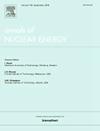Numerical simulation of bubble migration characteristics and distribution probability under lead-cooled fast reactor during SGTR accident
IF 1.9
3区 工程技术
Q1 NUCLEAR SCIENCE & TECHNOLOGY
引用次数: 0
Abstract
The phenomena of lead–bismuth fast reactors may lead to steam generator tube rupture (SGTR) accident. This accident results in heat exchange between high-pressure supercooled water and high-temperature liquid lead–bismuth metal (LBE), generating large number of bubbles. Some bubbles enter the core leading to local heat transfer deterioration and power transients. This study focuses on the European Lead-cooled System and utilizes a drag coefficient model based on bubble-LBE two-phase flow. It combines with the Porous Media Model and the Discrete Phase Model to simulate the migration of bubbles during SGTR accident. The study concludes that the smaller the bubble diameters, the easier it is carried into the core. As the LBE velocity increases, more bubbles can be carried into the core. The temperature change of LBE does not affect the entrainment ability of LBE. Additionally, when the rupture occurs at the bottom of the SG, there is a higher likelihood of bubbles accumulating in the core.
求助全文
约1分钟内获得全文
求助全文
来源期刊

Annals of Nuclear Energy
工程技术-核科学技术
CiteScore
4.30
自引率
21.10%
发文量
632
审稿时长
7.3 months
期刊介绍:
Annals of Nuclear Energy provides an international medium for the communication of original research, ideas and developments in all areas of the field of nuclear energy science and technology. Its scope embraces nuclear fuel reserves, fuel cycles and cost, materials, processing, system and component technology (fission only), design and optimization, direct conversion of nuclear energy sources, environmental control, reactor physics, heat transfer and fluid dynamics, structural analysis, fuel management, future developments, nuclear fuel and safety, nuclear aerosol, neutron physics, computer technology (both software and hardware), risk assessment, radioactive waste disposal and reactor thermal hydraulics. Papers submitted to Annals need to demonstrate a clear link to nuclear power generation/nuclear engineering. Papers which deal with pure nuclear physics, pure health physics, imaging, or attenuation and shielding properties of concretes and various geological materials are not within the scope of the journal. Also, papers that deal with policy or economics are not within the scope of the journal.
 求助内容:
求助内容: 应助结果提醒方式:
应助结果提醒方式:


